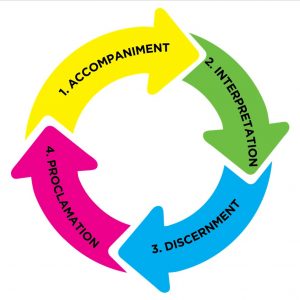The Riverside Innovation Hub is a learning community made of local congregations who gather together to learn how to be and become public church in their neighborhood contexts. We convene congregations over two years together, shaped by learning and practicing the artforms of the Public Church Framework in each congregation’s unique context.
Accompaniment is the first artform of the Public Church Framework. It is the movement out into the neighborhood to hear the neighbors’ stories. In this movement, we learn to engage and listen to the neighbor for the neighbor’s sake. We’ve simplified and categorized accompaniment into four different practices that help us hear our neighbors’ stories. This blog post dives into the last layer of accompaniment, one to ones.
You can also read more about the other three layers – Understanding Demographic Data, Prayer Walk in the Neighborhood, and Engaging Listening Posts.
Tools for Deep Conversations
Written by Brenna Zeimet
The desire to know and be known is at the core of our being as humans. Our compassion, our actions, and our hearts are driven by the relationships and stories of the people around us. When we understand others deeply and connect their experience to our own, we are compelled to love them, it is how we are wired.
Most of us navigate the world as the star of our own story, we spend our days running our errands, chasing our goals and interacting with the friends and family that complete our story’s cast of characters. Every single day we pass dozens of other humans, on the road, in our schools, in the grocery store, even on our own block. Like extras on a movie set, those people wander through the scenes that make up our days and for the most part, we are oblivious to their existence.
What if we got curious about the characters that pass us everyday? What if when we thought about the people who we share space with we saw human beings with stories and dreams and value. What if we began to investigate the depth and beauty and friendships that we are missing out on each day?
Any good story hinges on character development, we connect with the characters when we understand their essence. We want to know their backstory, their motivation, their strengths, their goals, how they think, what they love, what breaks their heart. Knowing your neighbor involves getting to know their essence, moving beyond surface conversation about the weather and sports, and having real, deep, curious conversations – conversations that result in knowing and being known. Continue reading “One to Ones: Tool for Deep Conversations”



